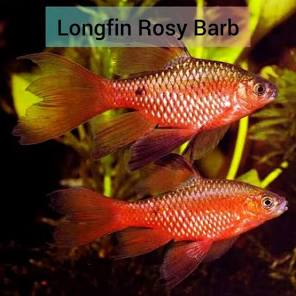1
/
of
1
Midwest Aquarium and Pond Supplier LLC
(24) Longfin Rosy Barb
(24) Longfin Rosy Barb
Regular price
$7.00 USD
Regular price
Sale price
$7.00 USD
Shipping calculated at checkout.
Quantity
Couldn't load pickup availability
The Longfin Rosy Barb (Pethia conchonius), a selectively bred variant of the standard Rosy Barb, is a popular and durable freshwater aquarium fish. It is known for its graceful, elongated fins and vibrant coloration, particularly in males.Appearance
- Color: Males develop a deep rosy-pink color, especially during courtship. Females are less vibrantly colored, with a more subdued yellowish-gold hue.
- Fins: The longfin variant has flowing, extended fins that trail behind them as they swim, giving them an elegant appearance.
- Size: This species can grow to be 3–6 inches (7.5–15 cm) long.
Habitat and tank requirements
- Schooling: As a schooling fish, the Longfin Rosy Barb should be kept in a group of at least five to eight individuals. Keeping them in a group reduces stress and discourages fin-nipping behavior.
- Tank size: A minimum tank size of 30 gallons is recommended for a small school to allow for their active swimming behavior. A longer tank is preferred to a taller one to provide ample swimming room.
- Aquascaping: Include plenty of open swimming space alongside planted areas, which provide hiding spots and encourage more natural behavior. A dark substrate can help highlight their colors.
-
Water parameters:
- Temperature: Prefers cooler water than many tropical fish, with an ideal range of 64–75°F (18–24°C).
- pH: Tolerates a wide range of 6.0–8.0.
- Hardness: Accepts soft to moderately hard water.
Behavior and tank mates
- Temperament: Generally peaceful and active, but can be boisterous and occasionally "nippy" towards fish with long, flowing fins. This behavior is minimized when they are kept in a large school.
- Compatibility: Good tank mates include other fast-swimming, medium-sized fish such as other barbs, danios, rainbowfish, and bottom-dwelling loaches or catfish. Avoid keeping them with slower-moving fish like angelfish or gouramis, which have vulnerable fins.
- Diet: An omnivore that readily accepts a variety of foods, including high-quality flakes and pellets. Supplement their diet with frozen or live foods like brine shrimp and bloodworms, as well as plant-based foods such as algae wafers and blanched vegetables.
Breeding
- Sexual dimorphism: Males are brighter red and more slender, while females are plumper and more golden or yellow. Males also have black markings on their fins.
- Process: They are egg-scatterers and do not show parental care. To breed them, place a conditioned pair in a separate breeding tank with fine-leaved plants or a spawning mop for the eggs to fall into. The eggs will hatch in about 30 hours.
Share
No reviews

